Sociology in Social Work
VerifiedAdded on 2023/04/20
|11
|3294
|168
AI Summary
This article explores the role of sociology in social work and its application in understanding mental health issues. It includes a case study analysis of Ms K and her struggles with paranoid schizophrenia, as well as an examination of sociological theories related to mental illness. The article also discusses the importance of anti-oppressive and anti-discriminatory practices in social work.
Contribute Materials
Your contribution can guide someone’s learning journey. Share your
documents today.
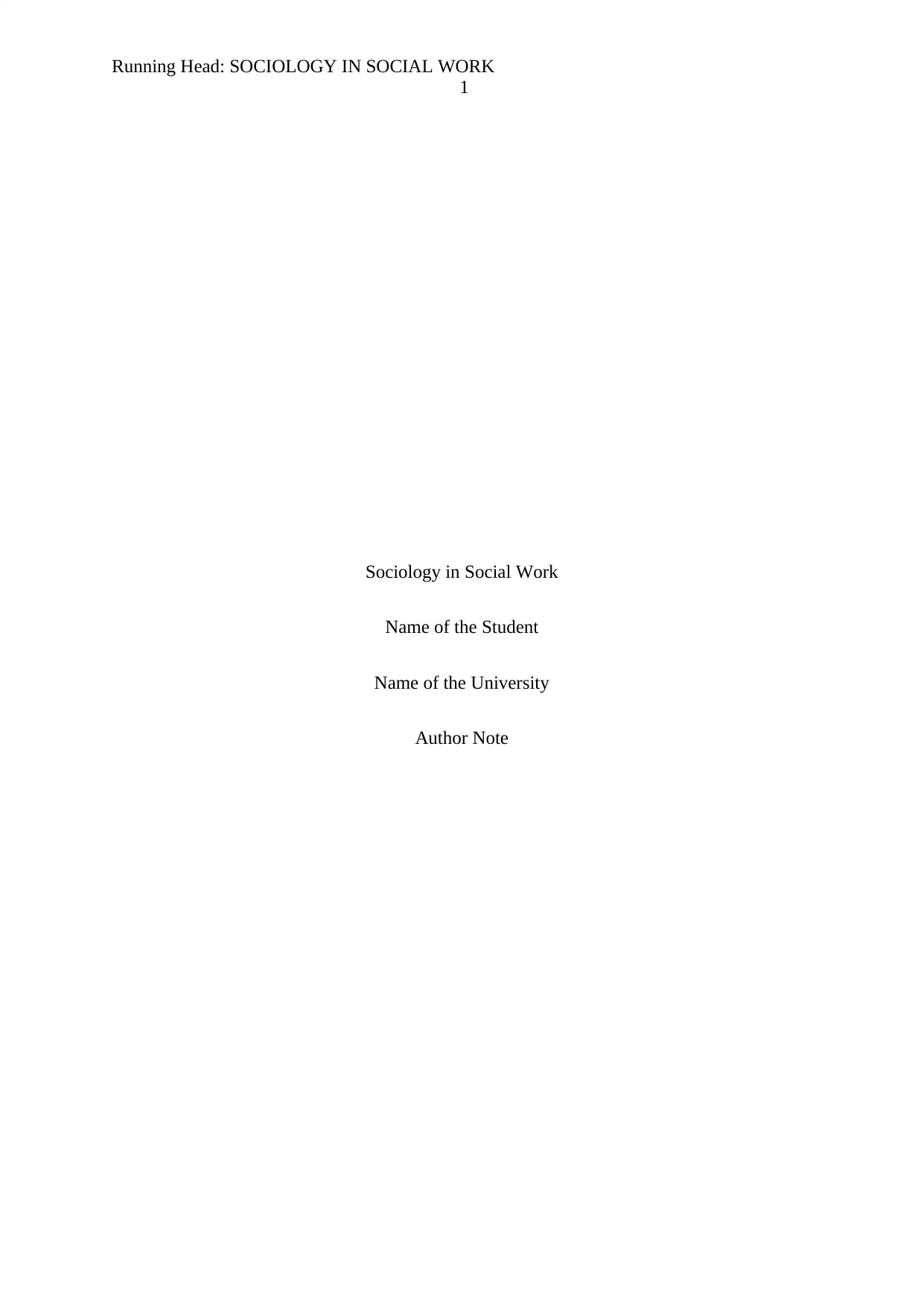
Running Head: SOCIOLOGY IN SOCIAL WORK
1
Sociology in Social Work
Name of the Student
Name of the University
Author Note
1
Sociology in Social Work
Name of the Student
Name of the University
Author Note
Secure Best Marks with AI Grader
Need help grading? Try our AI Grader for instant feedback on your assignments.
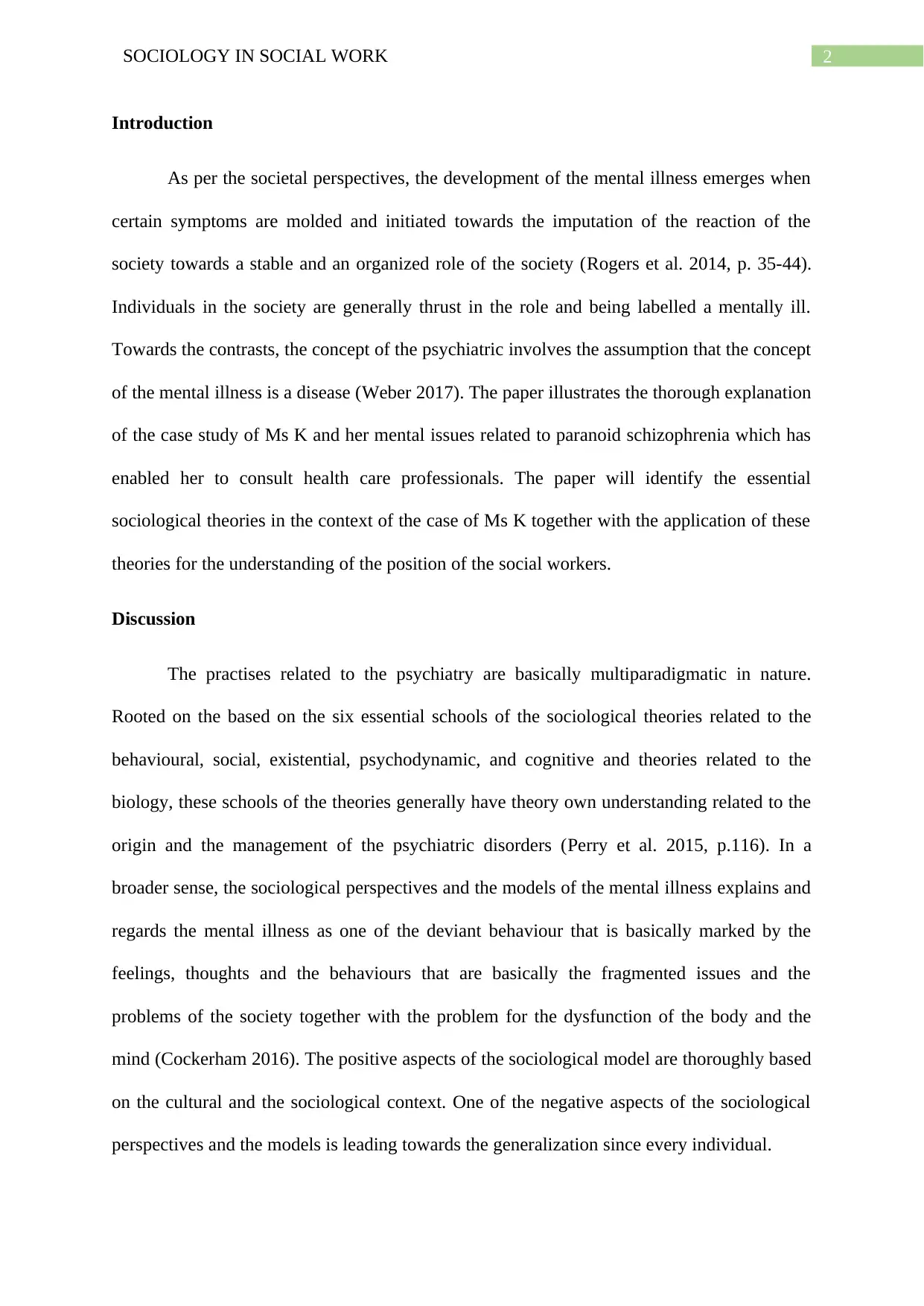
2SOCIOLOGY IN SOCIAL WORK
Introduction
As per the societal perspectives, the development of the mental illness emerges when
certain symptoms are molded and initiated towards the imputation of the reaction of the
society towards a stable and an organized role of the society (Rogers et al. 2014, p. 35-44).
Individuals in the society are generally thrust in the role and being labelled a mentally ill.
Towards the contrasts, the concept of the psychiatric involves the assumption that the concept
of the mental illness is a disease (Weber 2017). The paper illustrates the thorough explanation
of the case study of Ms K and her mental issues related to paranoid schizophrenia which has
enabled her to consult health care professionals. The paper will identify the essential
sociological theories in the context of the case of Ms K together with the application of these
theories for the understanding of the position of the social workers.
Discussion
The practises related to the psychiatry are basically multiparadigmatic in nature.
Rooted on the based on the six essential schools of the sociological theories related to the
behavioural, social, existential, psychodynamic, and cognitive and theories related to the
biology, these schools of the theories generally have theory own understanding related to the
origin and the management of the psychiatric disorders (Perry et al. 2015, p.116). In a
broader sense, the sociological perspectives and the models of the mental illness explains and
regards the mental illness as one of the deviant behaviour that is basically marked by the
feelings, thoughts and the behaviours that are basically the fragmented issues and the
problems of the society together with the problem for the dysfunction of the body and the
mind (Cockerham 2016). The positive aspects of the sociological model are thoroughly based
on the cultural and the sociological context. One of the negative aspects of the sociological
perspectives and the models is leading towards the generalization since every individual.
Introduction
As per the societal perspectives, the development of the mental illness emerges when
certain symptoms are molded and initiated towards the imputation of the reaction of the
society towards a stable and an organized role of the society (Rogers et al. 2014, p. 35-44).
Individuals in the society are generally thrust in the role and being labelled a mentally ill.
Towards the contrasts, the concept of the psychiatric involves the assumption that the concept
of the mental illness is a disease (Weber 2017). The paper illustrates the thorough explanation
of the case study of Ms K and her mental issues related to paranoid schizophrenia which has
enabled her to consult health care professionals. The paper will identify the essential
sociological theories in the context of the case of Ms K together with the application of these
theories for the understanding of the position of the social workers.
Discussion
The practises related to the psychiatry are basically multiparadigmatic in nature.
Rooted on the based on the six essential schools of the sociological theories related to the
behavioural, social, existential, psychodynamic, and cognitive and theories related to the
biology, these schools of the theories generally have theory own understanding related to the
origin and the management of the psychiatric disorders (Perry et al. 2015, p.116). In a
broader sense, the sociological perspectives and the models of the mental illness explains and
regards the mental illness as one of the deviant behaviour that is basically marked by the
feelings, thoughts and the behaviours that are basically the fragmented issues and the
problems of the society together with the problem for the dysfunction of the body and the
mind (Cockerham 2016). The positive aspects of the sociological model are thoroughly based
on the cultural and the sociological context. One of the negative aspects of the sociological
perspectives and the models is leading towards the generalization since every individual.
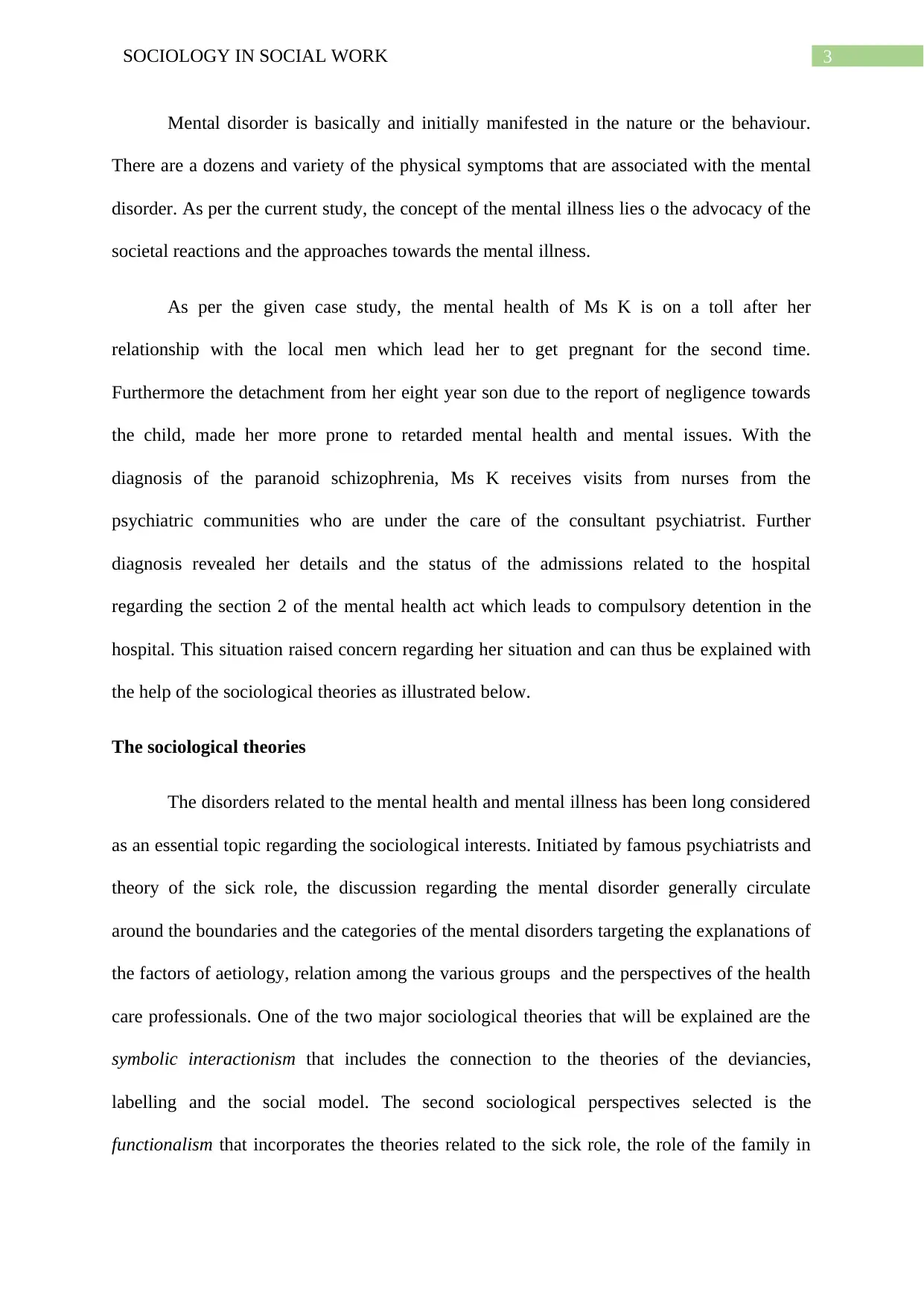
3SOCIOLOGY IN SOCIAL WORK
Mental disorder is basically and initially manifested in the nature or the behaviour.
There are a dozens and variety of the physical symptoms that are associated with the mental
disorder. As per the current study, the concept of the mental illness lies o the advocacy of the
societal reactions and the approaches towards the mental illness.
As per the given case study, the mental health of Ms K is on a toll after her
relationship with the local men which lead her to get pregnant for the second time.
Furthermore the detachment from her eight year son due to the report of negligence towards
the child, made her more prone to retarded mental health and mental issues. With the
diagnosis of the paranoid schizophrenia, Ms K receives visits from nurses from the
psychiatric communities who are under the care of the consultant psychiatrist. Further
diagnosis revealed her details and the status of the admissions related to the hospital
regarding the section 2 of the mental health act which leads to compulsory detention in the
hospital. This situation raised concern regarding her situation and can thus be explained with
the help of the sociological theories as illustrated below.
The sociological theories
The disorders related to the mental health and mental illness has been long considered
as an essential topic regarding the sociological interests. Initiated by famous psychiatrists and
theory of the sick role, the discussion regarding the mental disorder generally circulate
around the boundaries and the categories of the mental disorders targeting the explanations of
the factors of aetiology, relation among the various groups and the perspectives of the health
care professionals. One of the two major sociological theories that will be explained are the
symbolic interactionism that includes the connection to the theories of the deviancies,
labelling and the social model. The second sociological perspectives selected is the
functionalism that incorporates the theories related to the sick role, the role of the family in
Mental disorder is basically and initially manifested in the nature or the behaviour.
There are a dozens and variety of the physical symptoms that are associated with the mental
disorder. As per the current study, the concept of the mental illness lies o the advocacy of the
societal reactions and the approaches towards the mental illness.
As per the given case study, the mental health of Ms K is on a toll after her
relationship with the local men which lead her to get pregnant for the second time.
Furthermore the detachment from her eight year son due to the report of negligence towards
the child, made her more prone to retarded mental health and mental issues. With the
diagnosis of the paranoid schizophrenia, Ms K receives visits from nurses from the
psychiatric communities who are under the care of the consultant psychiatrist. Further
diagnosis revealed her details and the status of the admissions related to the hospital
regarding the section 2 of the mental health act which leads to compulsory detention in the
hospital. This situation raised concern regarding her situation and can thus be explained with
the help of the sociological theories as illustrated below.
The sociological theories
The disorders related to the mental health and mental illness has been long considered
as an essential topic regarding the sociological interests. Initiated by famous psychiatrists and
theory of the sick role, the discussion regarding the mental disorder generally circulate
around the boundaries and the categories of the mental disorders targeting the explanations of
the factors of aetiology, relation among the various groups and the perspectives of the health
care professionals. One of the two major sociological theories that will be explained are the
symbolic interactionism that includes the connection to the theories of the deviancies,
labelling and the social model. The second sociological perspectives selected is the
functionalism that incorporates the theories related to the sick role, the role of the family in
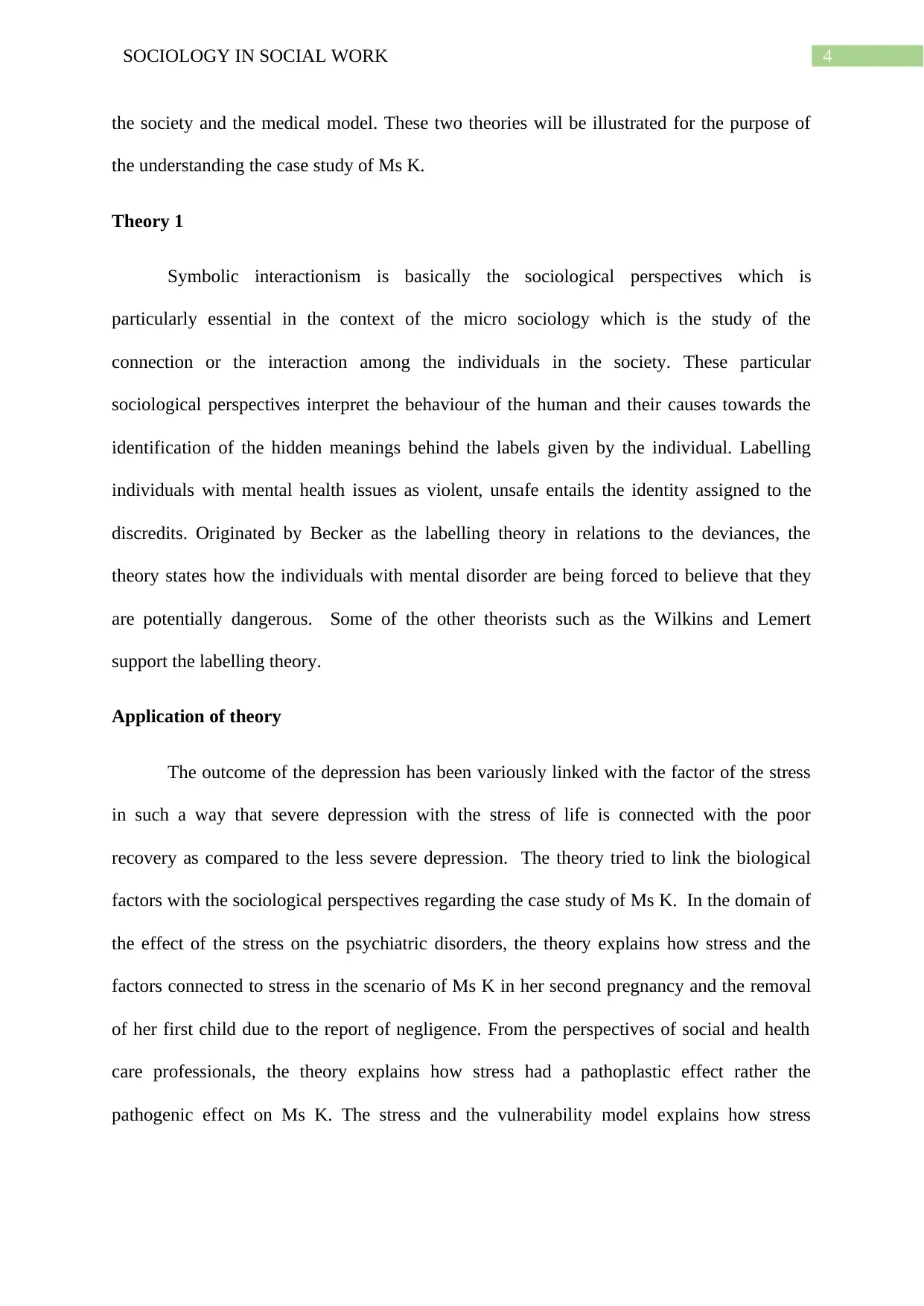
4SOCIOLOGY IN SOCIAL WORK
the society and the medical model. These two theories will be illustrated for the purpose of
the understanding the case study of Ms K.
Theory 1
Symbolic interactionism is basically the sociological perspectives which is
particularly essential in the context of the micro sociology which is the study of the
connection or the interaction among the individuals in the society. These particular
sociological perspectives interpret the behaviour of the human and their causes towards the
identification of the hidden meanings behind the labels given by the individual. Labelling
individuals with mental health issues as violent, unsafe entails the identity assigned to the
discredits. Originated by Becker as the labelling theory in relations to the deviances, the
theory states how the individuals with mental disorder are being forced to believe that they
are potentially dangerous. Some of the other theorists such as the Wilkins and Lemert
support the labelling theory.
Application of theory
The outcome of the depression has been variously linked with the factor of the stress
in such a way that severe depression with the stress of life is connected with the poor
recovery as compared to the less severe depression. The theory tried to link the biological
factors with the sociological perspectives regarding the case study of Ms K. In the domain of
the effect of the stress on the psychiatric disorders, the theory explains how stress and the
factors connected to stress in the scenario of Ms K in her second pregnancy and the removal
of her first child due to the report of negligence. From the perspectives of social and health
care professionals, the theory explains how stress had a pathoplastic effect rather the
pathogenic effect on Ms K. The stress and the vulnerability model explains how stress
the society and the medical model. These two theories will be illustrated for the purpose of
the understanding the case study of Ms K.
Theory 1
Symbolic interactionism is basically the sociological perspectives which is
particularly essential in the context of the micro sociology which is the study of the
connection or the interaction among the individuals in the society. These particular
sociological perspectives interpret the behaviour of the human and their causes towards the
identification of the hidden meanings behind the labels given by the individual. Labelling
individuals with mental health issues as violent, unsafe entails the identity assigned to the
discredits. Originated by Becker as the labelling theory in relations to the deviances, the
theory states how the individuals with mental disorder are being forced to believe that they
are potentially dangerous. Some of the other theorists such as the Wilkins and Lemert
support the labelling theory.
Application of theory
The outcome of the depression has been variously linked with the factor of the stress
in such a way that severe depression with the stress of life is connected with the poor
recovery as compared to the less severe depression. The theory tried to link the biological
factors with the sociological perspectives regarding the case study of Ms K. In the domain of
the effect of the stress on the psychiatric disorders, the theory explains how stress and the
factors connected to stress in the scenario of Ms K in her second pregnancy and the removal
of her first child due to the report of negligence. From the perspectives of social and health
care professionals, the theory explains how stress had a pathoplastic effect rather the
pathogenic effect on Ms K. The stress and the vulnerability model explains how stress
Secure Best Marks with AI Grader
Need help grading? Try our AI Grader for instant feedback on your assignments.
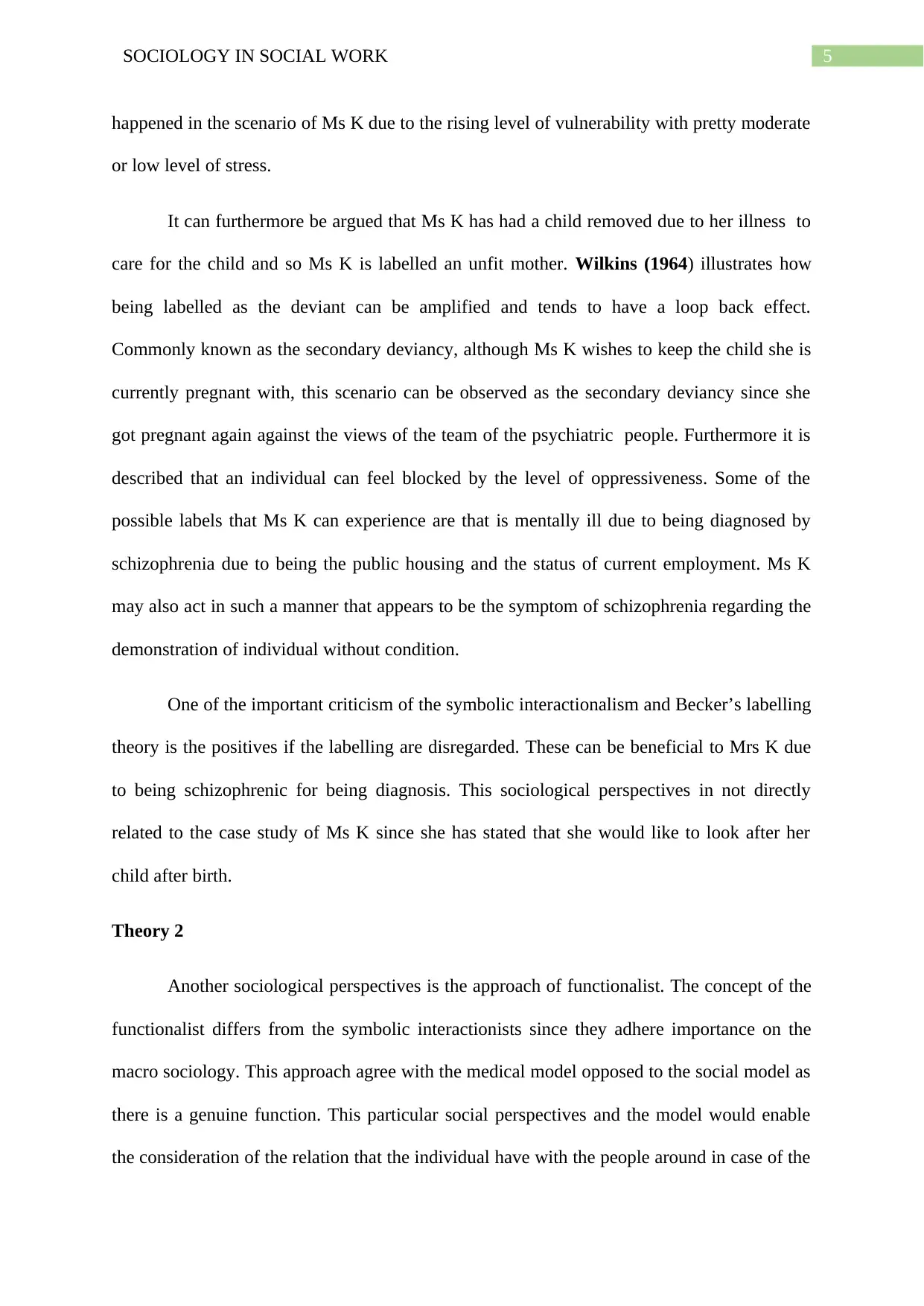
5SOCIOLOGY IN SOCIAL WORK
happened in the scenario of Ms K due to the rising level of vulnerability with pretty moderate
or low level of stress.
It can furthermore be argued that Ms K has had a child removed due to her illness to
care for the child and so Ms K is labelled an unfit mother. Wilkins (1964) illustrates how
being labelled as the deviant can be amplified and tends to have a loop back effect.
Commonly known as the secondary deviancy, although Ms K wishes to keep the child she is
currently pregnant with, this scenario can be observed as the secondary deviancy since she
got pregnant again against the views of the team of the psychiatric people. Furthermore it is
described that an individual can feel blocked by the level of oppressiveness. Some of the
possible labels that Ms K can experience are that is mentally ill due to being diagnosed by
schizophrenia due to being the public housing and the status of current employment. Ms K
may also act in such a manner that appears to be the symptom of schizophrenia regarding the
demonstration of individual without condition.
One of the important criticism of the symbolic interactionalism and Becker’s labelling
theory is the positives if the labelling are disregarded. These can be beneficial to Mrs K due
to being schizophrenic for being diagnosis. This sociological perspectives in not directly
related to the case study of Ms K since she has stated that she would like to look after her
child after birth.
Theory 2
Another sociological perspectives is the approach of functionalist. The concept of the
functionalist differs from the symbolic interactionists since they adhere importance on the
macro sociology. This approach agree with the medical model opposed to the social model as
there is a genuine function. This particular social perspectives and the model would enable
the consideration of the relation that the individual have with the people around in case of the
happened in the scenario of Ms K due to the rising level of vulnerability with pretty moderate
or low level of stress.
It can furthermore be argued that Ms K has had a child removed due to her illness to
care for the child and so Ms K is labelled an unfit mother. Wilkins (1964) illustrates how
being labelled as the deviant can be amplified and tends to have a loop back effect.
Commonly known as the secondary deviancy, although Ms K wishes to keep the child she is
currently pregnant with, this scenario can be observed as the secondary deviancy since she
got pregnant again against the views of the team of the psychiatric people. Furthermore it is
described that an individual can feel blocked by the level of oppressiveness. Some of the
possible labels that Ms K can experience are that is mentally ill due to being diagnosed by
schizophrenia due to being the public housing and the status of current employment. Ms K
may also act in such a manner that appears to be the symptom of schizophrenia regarding the
demonstration of individual without condition.
One of the important criticism of the symbolic interactionalism and Becker’s labelling
theory is the positives if the labelling are disregarded. These can be beneficial to Mrs K due
to being schizophrenic for being diagnosis. This sociological perspectives in not directly
related to the case study of Ms K since she has stated that she would like to look after her
child after birth.
Theory 2
Another sociological perspectives is the approach of functionalist. The concept of the
functionalist differs from the symbolic interactionists since they adhere importance on the
macro sociology. This approach agree with the medical model opposed to the social model as
there is a genuine function. This particular social perspectives and the model would enable
the consideration of the relation that the individual have with the people around in case of the
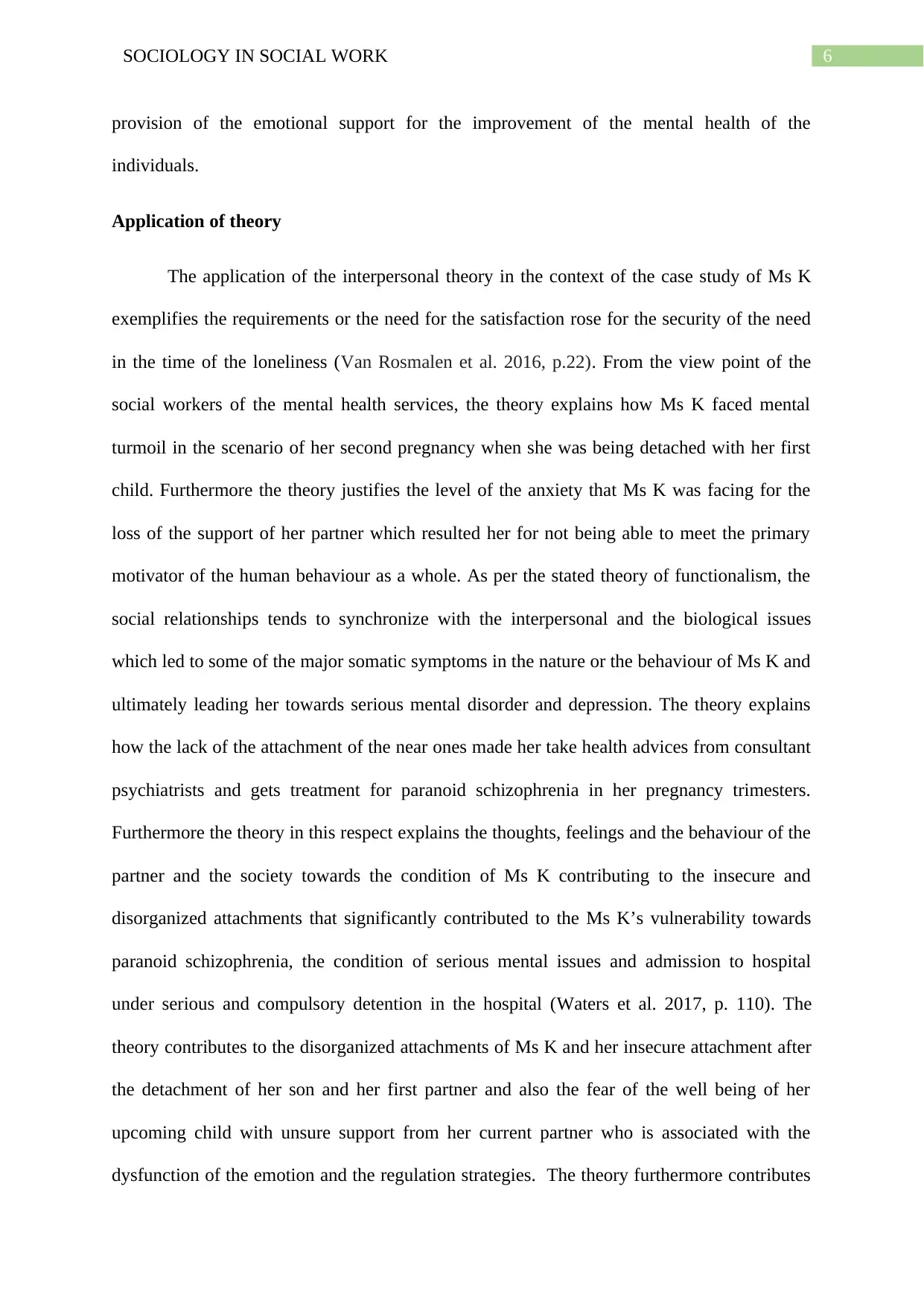
6SOCIOLOGY IN SOCIAL WORK
provision of the emotional support for the improvement of the mental health of the
individuals.
Application of theory
The application of the interpersonal theory in the context of the case study of Ms K
exemplifies the requirements or the need for the satisfaction rose for the security of the need
in the time of the loneliness (Van Rosmalen et al. 2016, p.22). From the view point of the
social workers of the mental health services, the theory explains how Ms K faced mental
turmoil in the scenario of her second pregnancy when she was being detached with her first
child. Furthermore the theory justifies the level of the anxiety that Ms K was facing for the
loss of the support of her partner which resulted her for not being able to meet the primary
motivator of the human behaviour as a whole. As per the stated theory of functionalism, the
social relationships tends to synchronize with the interpersonal and the biological issues
which led to some of the major somatic symptoms in the nature or the behaviour of Ms K and
ultimately leading her towards serious mental disorder and depression. The theory explains
how the lack of the attachment of the near ones made her take health advices from consultant
psychiatrists and gets treatment for paranoid schizophrenia in her pregnancy trimesters.
Furthermore the theory in this respect explains the thoughts, feelings and the behaviour of the
partner and the society towards the condition of Ms K contributing to the insecure and
disorganized attachments that significantly contributed to the Ms K’s vulnerability towards
paranoid schizophrenia, the condition of serious mental issues and admission to hospital
under serious and compulsory detention in the hospital (Waters et al. 2017, p. 110). The
theory contributes to the disorganized attachments of Ms K and her insecure attachment after
the detachment of her son and her first partner and also the fear of the well being of her
upcoming child with unsure support from her current partner who is associated with the
dysfunction of the emotion and the regulation strategies. The theory furthermore contributes
provision of the emotional support for the improvement of the mental health of the
individuals.
Application of theory
The application of the interpersonal theory in the context of the case study of Ms K
exemplifies the requirements or the need for the satisfaction rose for the security of the need
in the time of the loneliness (Van Rosmalen et al. 2016, p.22). From the view point of the
social workers of the mental health services, the theory explains how Ms K faced mental
turmoil in the scenario of her second pregnancy when she was being detached with her first
child. Furthermore the theory justifies the level of the anxiety that Ms K was facing for the
loss of the support of her partner which resulted her for not being able to meet the primary
motivator of the human behaviour as a whole. As per the stated theory of functionalism, the
social relationships tends to synchronize with the interpersonal and the biological issues
which led to some of the major somatic symptoms in the nature or the behaviour of Ms K and
ultimately leading her towards serious mental disorder and depression. The theory explains
how the lack of the attachment of the near ones made her take health advices from consultant
psychiatrists and gets treatment for paranoid schizophrenia in her pregnancy trimesters.
Furthermore the theory in this respect explains the thoughts, feelings and the behaviour of the
partner and the society towards the condition of Ms K contributing to the insecure and
disorganized attachments that significantly contributed to the Ms K’s vulnerability towards
paranoid schizophrenia, the condition of serious mental issues and admission to hospital
under serious and compulsory detention in the hospital (Waters et al. 2017, p. 110). The
theory contributes to the disorganized attachments of Ms K and her insecure attachment after
the detachment of her son and her first partner and also the fear of the well being of her
upcoming child with unsure support from her current partner who is associated with the
dysfunction of the emotion and the regulation strategies. The theory furthermore contributes
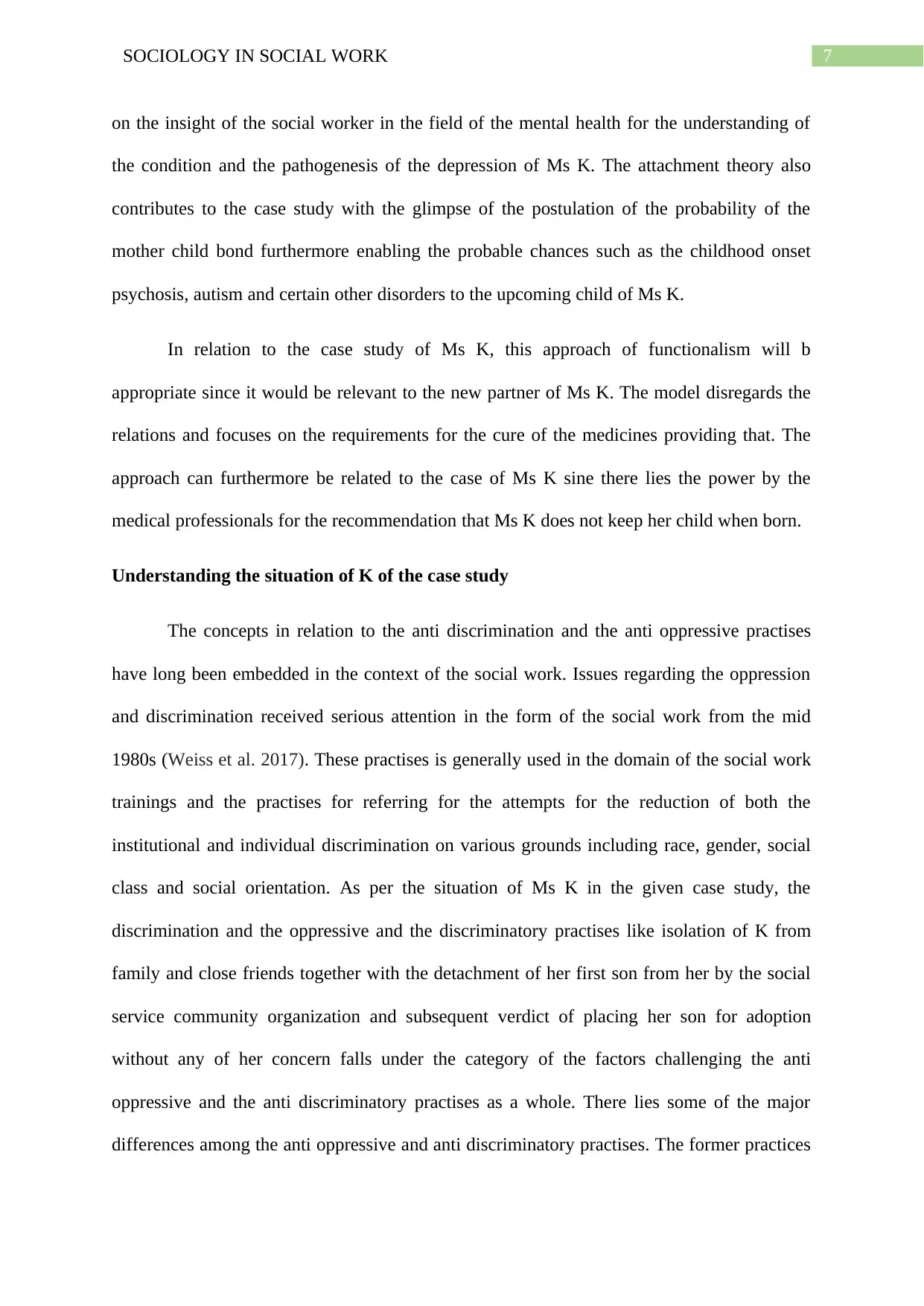
7SOCIOLOGY IN SOCIAL WORK
on the insight of the social worker in the field of the mental health for the understanding of
the condition and the pathogenesis of the depression of Ms K. The attachment theory also
contributes to the case study with the glimpse of the postulation of the probability of the
mother child bond furthermore enabling the probable chances such as the childhood onset
psychosis, autism and certain other disorders to the upcoming child of Ms K.
In relation to the case study of Ms K, this approach of functionalism will b
appropriate since it would be relevant to the new partner of Ms K. The model disregards the
relations and focuses on the requirements for the cure of the medicines providing that. The
approach can furthermore be related to the case of Ms K sine there lies the power by the
medical professionals for the recommendation that Ms K does not keep her child when born.
Understanding the situation of K of the case study
The concepts in relation to the anti discrimination and the anti oppressive practises
have long been embedded in the context of the social work. Issues regarding the oppression
and discrimination received serious attention in the form of the social work from the mid
1980s (Weiss et al. 2017). These practises is generally used in the domain of the social work
trainings and the practises for referring for the attempts for the reduction of both the
institutional and individual discrimination on various grounds including race, gender, social
class and social orientation. As per the situation of Ms K in the given case study, the
discrimination and the oppressive and the discriminatory practises like isolation of K from
family and close friends together with the detachment of her first son from her by the social
service community organization and subsequent verdict of placing her son for adoption
without any of her concern falls under the category of the factors challenging the anti
oppressive and the anti discriminatory practises as a whole. There lies some of the major
differences among the anti oppressive and anti discriminatory practises. The former practices
on the insight of the social worker in the field of the mental health for the understanding of
the condition and the pathogenesis of the depression of Ms K. The attachment theory also
contributes to the case study with the glimpse of the postulation of the probability of the
mother child bond furthermore enabling the probable chances such as the childhood onset
psychosis, autism and certain other disorders to the upcoming child of Ms K.
In relation to the case study of Ms K, this approach of functionalism will b
appropriate since it would be relevant to the new partner of Ms K. The model disregards the
relations and focuses on the requirements for the cure of the medicines providing that. The
approach can furthermore be related to the case of Ms K sine there lies the power by the
medical professionals for the recommendation that Ms K does not keep her child when born.
Understanding the situation of K of the case study
The concepts in relation to the anti discrimination and the anti oppressive practises
have long been embedded in the context of the social work. Issues regarding the oppression
and discrimination received serious attention in the form of the social work from the mid
1980s (Weiss et al. 2017). These practises is generally used in the domain of the social work
trainings and the practises for referring for the attempts for the reduction of both the
institutional and individual discrimination on various grounds including race, gender, social
class and social orientation. As per the situation of Ms K in the given case study, the
discrimination and the oppressive and the discriminatory practises like isolation of K from
family and close friends together with the detachment of her first son from her by the social
service community organization and subsequent verdict of placing her son for adoption
without any of her concern falls under the category of the factors challenging the anti
oppressive and the anti discriminatory practises as a whole. There lies some of the major
differences among the anti oppressive and anti discriminatory practises. The former practices
Paraphrase This Document
Need a fresh take? Get an instant paraphrase of this document with our AI Paraphraser
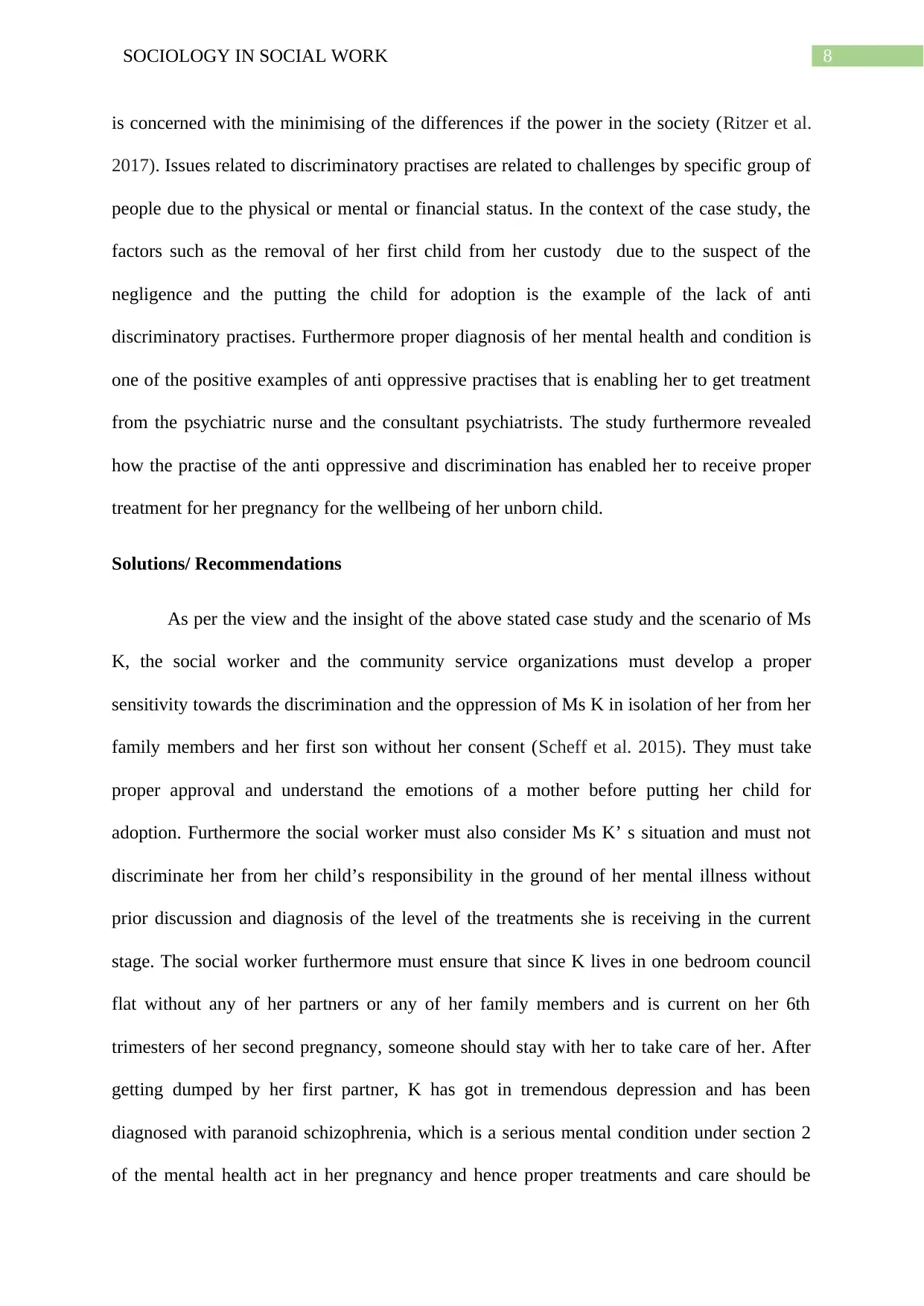
8SOCIOLOGY IN SOCIAL WORK
is concerned with the minimising of the differences if the power in the society (Ritzer et al.
2017). Issues related to discriminatory practises are related to challenges by specific group of
people due to the physical or mental or financial status. In the context of the case study, the
factors such as the removal of her first child from her custody due to the suspect of the
negligence and the putting the child for adoption is the example of the lack of anti
discriminatory practises. Furthermore proper diagnosis of her mental health and condition is
one of the positive examples of anti oppressive practises that is enabling her to get treatment
from the psychiatric nurse and the consultant psychiatrists. The study furthermore revealed
how the practise of the anti oppressive and discrimination has enabled her to receive proper
treatment for her pregnancy for the wellbeing of her unborn child.
Solutions/ Recommendations
As per the view and the insight of the above stated case study and the scenario of Ms
K, the social worker and the community service organizations must develop a proper
sensitivity towards the discrimination and the oppression of Ms K in isolation of her from her
family members and her first son without her consent (Scheff et al. 2015). They must take
proper approval and understand the emotions of a mother before putting her child for
adoption. Furthermore the social worker must also consider Ms K’ s situation and must not
discriminate her from her child’s responsibility in the ground of her mental illness without
prior discussion and diagnosis of the level of the treatments she is receiving in the current
stage. The social worker furthermore must ensure that since K lives in one bedroom council
flat without any of her partners or any of her family members and is current on her 6th
trimesters of her second pregnancy, someone should stay with her to take care of her. After
getting dumped by her first partner, K has got in tremendous depression and has been
diagnosed with paranoid schizophrenia, which is a serious mental condition under section 2
of the mental health act in her pregnancy and hence proper treatments and care should be
is concerned with the minimising of the differences if the power in the society (Ritzer et al.
2017). Issues related to discriminatory practises are related to challenges by specific group of
people due to the physical or mental or financial status. In the context of the case study, the
factors such as the removal of her first child from her custody due to the suspect of the
negligence and the putting the child for adoption is the example of the lack of anti
discriminatory practises. Furthermore proper diagnosis of her mental health and condition is
one of the positive examples of anti oppressive practises that is enabling her to get treatment
from the psychiatric nurse and the consultant psychiatrists. The study furthermore revealed
how the practise of the anti oppressive and discrimination has enabled her to receive proper
treatment for her pregnancy for the wellbeing of her unborn child.
Solutions/ Recommendations
As per the view and the insight of the above stated case study and the scenario of Ms
K, the social worker and the community service organizations must develop a proper
sensitivity towards the discrimination and the oppression of Ms K in isolation of her from her
family members and her first son without her consent (Scheff et al. 2015). They must take
proper approval and understand the emotions of a mother before putting her child for
adoption. Furthermore the social worker must also consider Ms K’ s situation and must not
discriminate her from her child’s responsibility in the ground of her mental illness without
prior discussion and diagnosis of the level of the treatments she is receiving in the current
stage. The social worker furthermore must ensure that since K lives in one bedroom council
flat without any of her partners or any of her family members and is current on her 6th
trimesters of her second pregnancy, someone should stay with her to take care of her. After
getting dumped by her first partner, K has got in tremendous depression and has been
diagnosed with paranoid schizophrenia, which is a serious mental condition under section 2
of the mental health act in her pregnancy and hence proper treatments and care should be
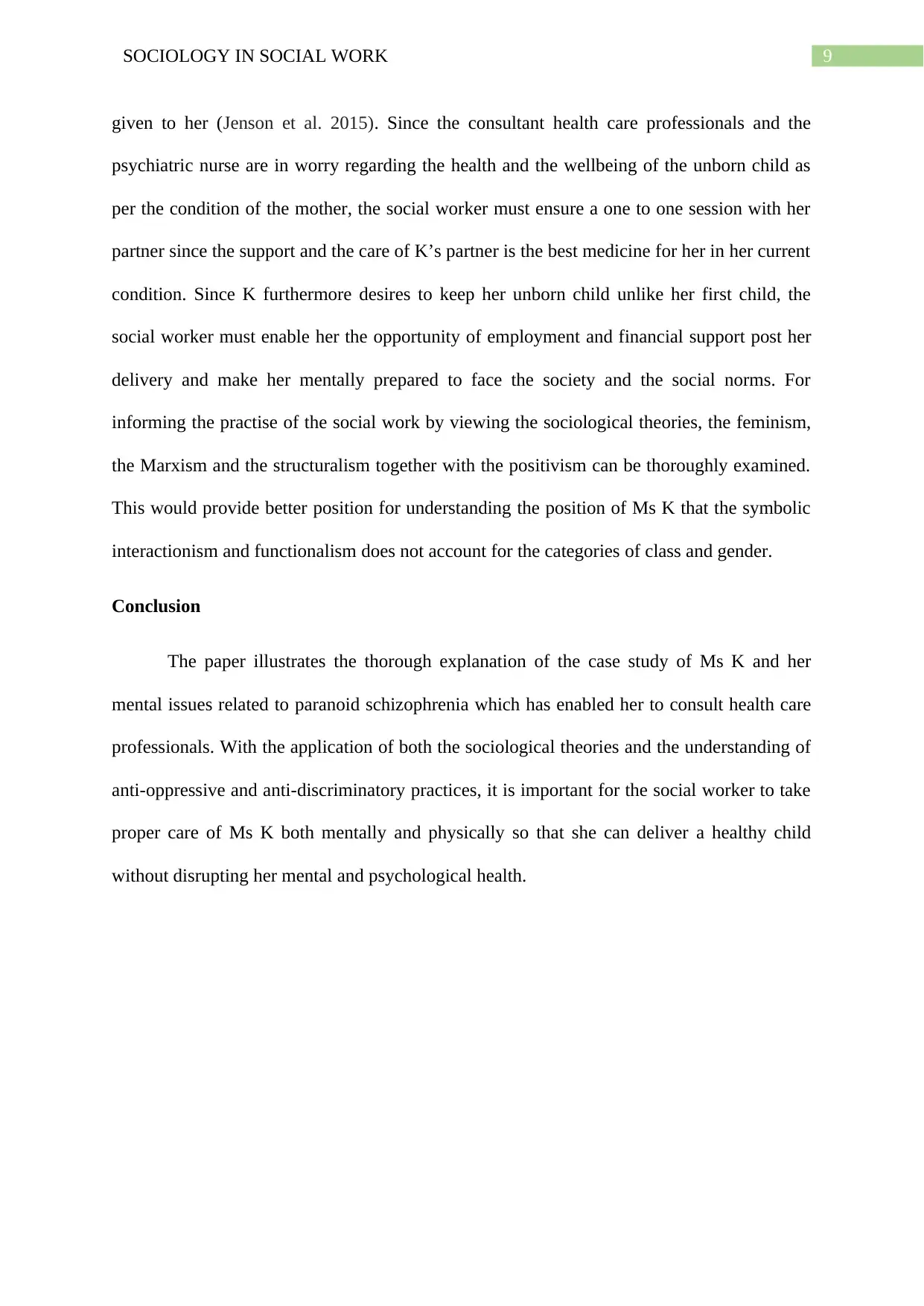
9SOCIOLOGY IN SOCIAL WORK
given to her (Jenson et al. 2015). Since the consultant health care professionals and the
psychiatric nurse are in worry regarding the health and the wellbeing of the unborn child as
per the condition of the mother, the social worker must ensure a one to one session with her
partner since the support and the care of K’s partner is the best medicine for her in her current
condition. Since K furthermore desires to keep her unborn child unlike her first child, the
social worker must enable her the opportunity of employment and financial support post her
delivery and make her mentally prepared to face the society and the social norms. For
informing the practise of the social work by viewing the sociological theories, the feminism,
the Marxism and the structuralism together with the positivism can be thoroughly examined.
This would provide better position for understanding the position of Ms K that the symbolic
interactionism and functionalism does not account for the categories of class and gender.
Conclusion
The paper illustrates the thorough explanation of the case study of Ms K and her
mental issues related to paranoid schizophrenia which has enabled her to consult health care
professionals. With the application of both the sociological theories and the understanding of
anti-oppressive and anti-discriminatory practices, it is important for the social worker to take
proper care of Ms K both mentally and physically so that she can deliver a healthy child
without disrupting her mental and psychological health.
given to her (Jenson et al. 2015). Since the consultant health care professionals and the
psychiatric nurse are in worry regarding the health and the wellbeing of the unborn child as
per the condition of the mother, the social worker must ensure a one to one session with her
partner since the support and the care of K’s partner is the best medicine for her in her current
condition. Since K furthermore desires to keep her unborn child unlike her first child, the
social worker must enable her the opportunity of employment and financial support post her
delivery and make her mentally prepared to face the society and the social norms. For
informing the practise of the social work by viewing the sociological theories, the feminism,
the Marxism and the structuralism together with the positivism can be thoroughly examined.
This would provide better position for understanding the position of Ms K that the symbolic
interactionism and functionalism does not account for the categories of class and gender.
Conclusion
The paper illustrates the thorough explanation of the case study of Ms K and her
mental issues related to paranoid schizophrenia which has enabled her to consult health care
professionals. With the application of both the sociological theories and the understanding of
anti-oppressive and anti-discriminatory practices, it is important for the social worker to take
proper care of Ms K both mentally and physically so that she can deliver a healthy child
without disrupting her mental and psychological health.
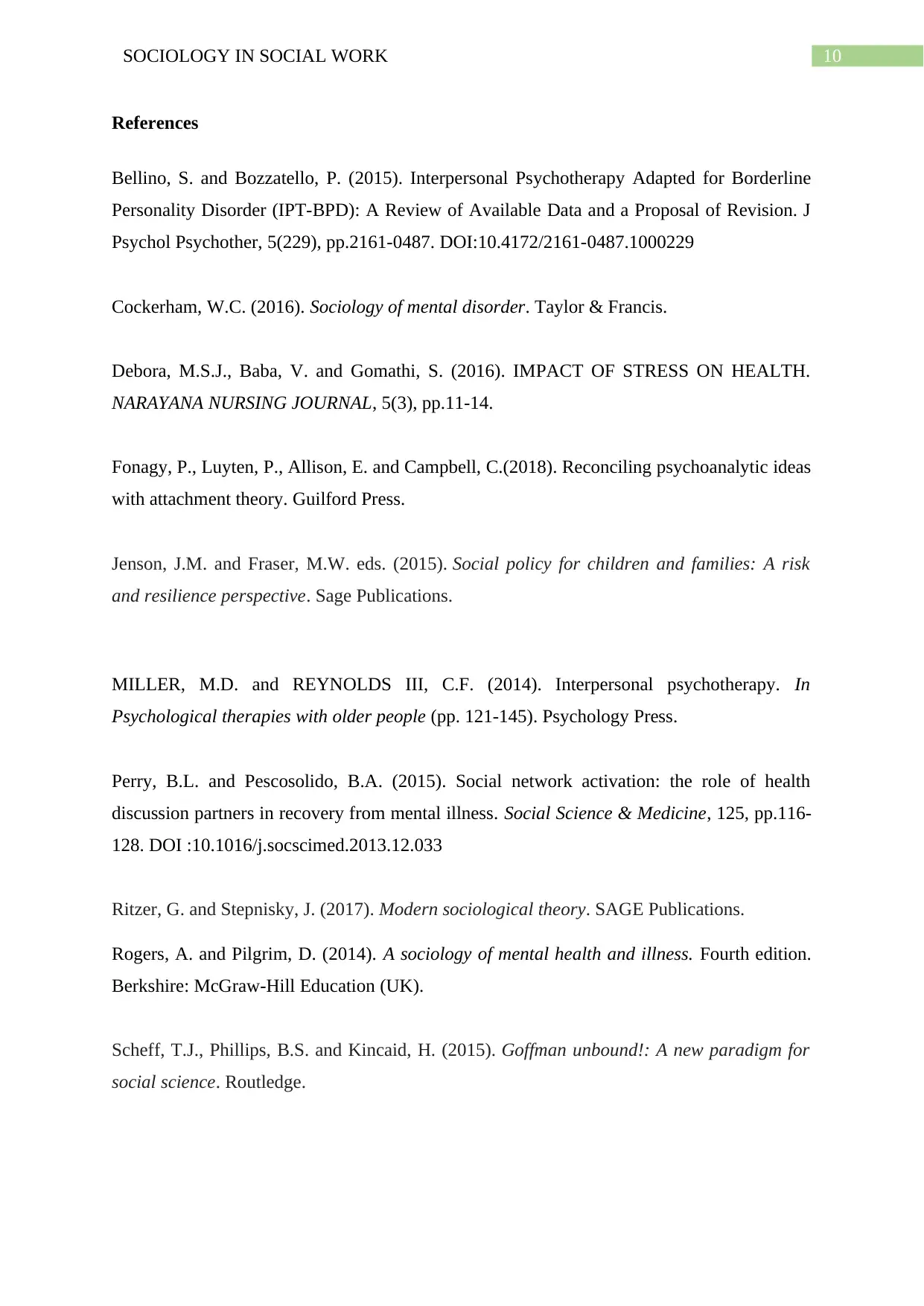
10SOCIOLOGY IN SOCIAL WORK
References
Bellino, S. and Bozzatello, P. (2015). Interpersonal Psychotherapy Adapted for Borderline
Personality Disorder (IPT-BPD): A Review of Available Data and a Proposal of Revision. J
Psychol Psychother, 5(229), pp.2161-0487. DOI:10.4172/2161-0487.1000229
Cockerham, W.C. (2016). Sociology of mental disorder. Taylor & Francis.
Debora, M.S.J., Baba, V. and Gomathi, S. (2016). IMPACT OF STRESS ON HEALTH.
NARAYANA NURSING JOURNAL, 5(3), pp.11-14.
Fonagy, P., Luyten, P., Allison, E. and Campbell, C.(2018). Reconciling psychoanalytic ideas
with attachment theory. Guilford Press.
Jenson, J.M. and Fraser, M.W. eds. (2015). Social policy for children and families: A risk
and resilience perspective. Sage Publications.
MILLER, M.D. and REYNOLDS III, C.F. (2014). Interpersonal psychotherapy. In
Psychological therapies with older people (pp. 121-145). Psychology Press.
Perry, B.L. and Pescosolido, B.A. (2015). Social network activation: the role of health
discussion partners in recovery from mental illness. Social Science & Medicine, 125, pp.116-
128. DOI :10.1016/j.socscimed.2013.12.033
Ritzer, G. and Stepnisky, J. (2017). Modern sociological theory. SAGE Publications.
Rogers, A. and Pilgrim, D. (2014). A sociology of mental health and illness. Fourth edition.
Berkshire: McGraw-Hill Education (UK).
Scheff, T.J., Phillips, B.S. and Kincaid, H. (2015). Goffman unbound!: A new paradigm for
social science. Routledge.
References
Bellino, S. and Bozzatello, P. (2015). Interpersonal Psychotherapy Adapted for Borderline
Personality Disorder (IPT-BPD): A Review of Available Data and a Proposal of Revision. J
Psychol Psychother, 5(229), pp.2161-0487. DOI:10.4172/2161-0487.1000229
Cockerham, W.C. (2016). Sociology of mental disorder. Taylor & Francis.
Debora, M.S.J., Baba, V. and Gomathi, S. (2016). IMPACT OF STRESS ON HEALTH.
NARAYANA NURSING JOURNAL, 5(3), pp.11-14.
Fonagy, P., Luyten, P., Allison, E. and Campbell, C.(2018). Reconciling psychoanalytic ideas
with attachment theory. Guilford Press.
Jenson, J.M. and Fraser, M.W. eds. (2015). Social policy for children and families: A risk
and resilience perspective. Sage Publications.
MILLER, M.D. and REYNOLDS III, C.F. (2014). Interpersonal psychotherapy. In
Psychological therapies with older people (pp. 121-145). Psychology Press.
Perry, B.L. and Pescosolido, B.A. (2015). Social network activation: the role of health
discussion partners in recovery from mental illness. Social Science & Medicine, 125, pp.116-
128. DOI :10.1016/j.socscimed.2013.12.033
Ritzer, G. and Stepnisky, J. (2017). Modern sociological theory. SAGE Publications.
Rogers, A. and Pilgrim, D. (2014). A sociology of mental health and illness. Fourth edition.
Berkshire: McGraw-Hill Education (UK).
Scheff, T.J., Phillips, B.S. and Kincaid, H. (2015). Goffman unbound!: A new paradigm for
social science. Routledge.
Secure Best Marks with AI Grader
Need help grading? Try our AI Grader for instant feedback on your assignments.
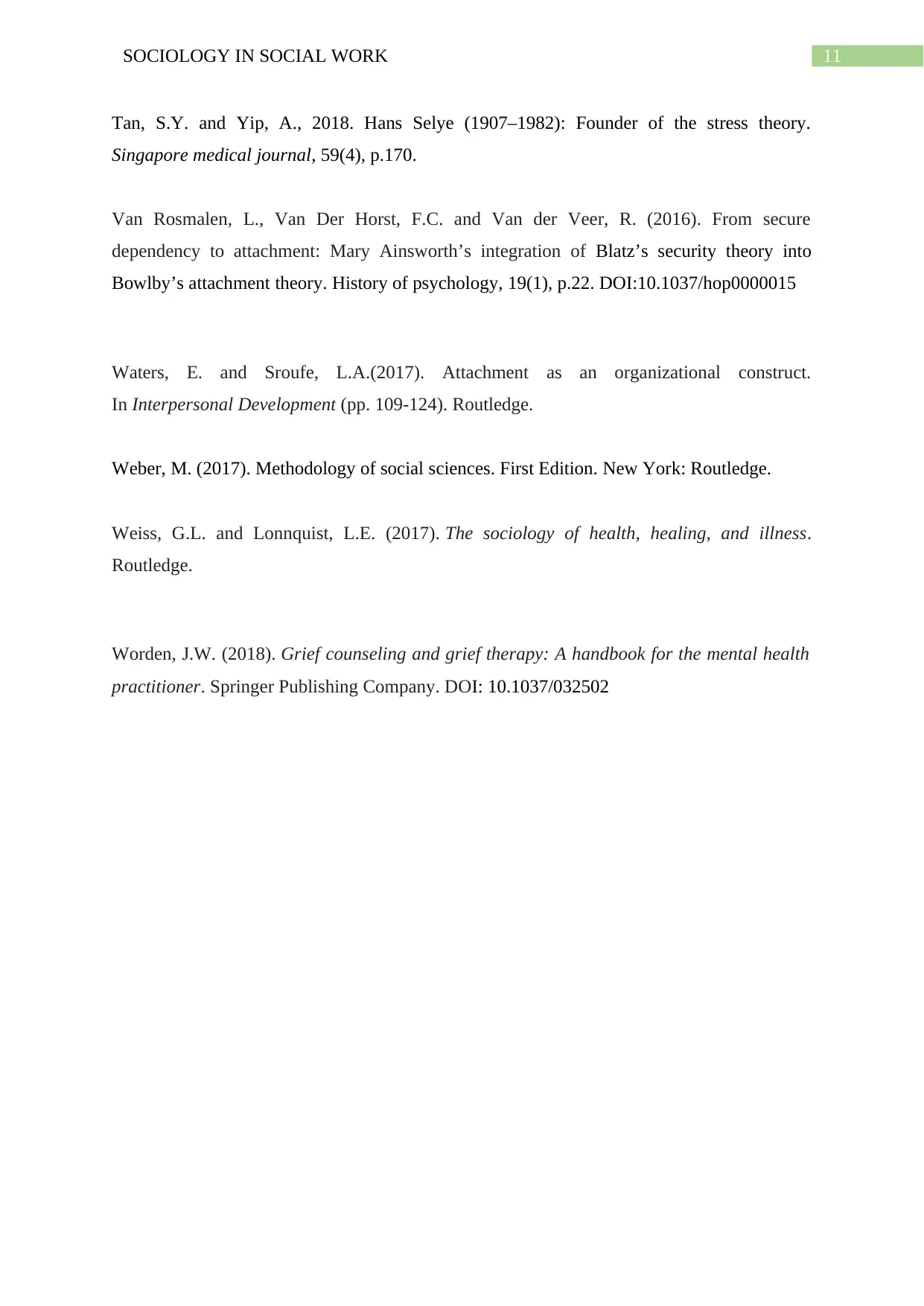
11SOCIOLOGY IN SOCIAL WORK
Tan, S.Y. and Yip, A., 2018. Hans Selye (1907–1982): Founder of the stress theory.
Singapore medical journal, 59(4), p.170.
Van Rosmalen, L., Van Der Horst, F.C. and Van der Veer, R. (2016). From secure
dependency to attachment: Mary Ainsworth’s integration of Blatz’s security theory into
Bowlby’s attachment theory. History of psychology, 19(1), p.22. DOI:10.1037/hop0000015
Waters, E. and Sroufe, L.A.(2017). Attachment as an organizational construct.
In Interpersonal Development (pp. 109-124). Routledge.
Weber, M. (2017). Methodology of social sciences. First Edition. New York: Routledge.
Weiss, G.L. and Lonnquist, L.E. (2017). The sociology of health, healing, and illness.
Routledge.
Worden, J.W. (2018). Grief counseling and grief therapy: A handbook for the mental health
practitioner. Springer Publishing Company. DOI: 10.1037/032502
Tan, S.Y. and Yip, A., 2018. Hans Selye (1907–1982): Founder of the stress theory.
Singapore medical journal, 59(4), p.170.
Van Rosmalen, L., Van Der Horst, F.C. and Van der Veer, R. (2016). From secure
dependency to attachment: Mary Ainsworth’s integration of Blatz’s security theory into
Bowlby’s attachment theory. History of psychology, 19(1), p.22. DOI:10.1037/hop0000015
Waters, E. and Sroufe, L.A.(2017). Attachment as an organizational construct.
In Interpersonal Development (pp. 109-124). Routledge.
Weber, M. (2017). Methodology of social sciences. First Edition. New York: Routledge.
Weiss, G.L. and Lonnquist, L.E. (2017). The sociology of health, healing, and illness.
Routledge.
Worden, J.W. (2018). Grief counseling and grief therapy: A handbook for the mental health
practitioner. Springer Publishing Company. DOI: 10.1037/032502
1 out of 11
Related Documents
Your All-in-One AI-Powered Toolkit for Academic Success.
+13062052269
info@desklib.com
Available 24*7 on WhatsApp / Email
![[object Object]](/_next/static/media/star-bottom.7253800d.svg)
Unlock your academic potential
© 2024 | Zucol Services PVT LTD | All rights reserved.





